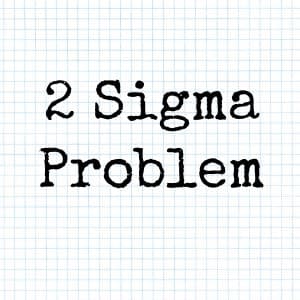Back to Bloom: Solving the 2 Sigma Problem with Online CBE
CompetencyWorks Blog
 Originally posted October 22, 2014 at the Christensen Institute.
Originally posted October 22, 2014 at the Christensen Institute.
The term competency-based education (CBE) is a lot like the term disruption. It gets misused more frequently than it is deployed correctly. So when I write about both topics at the same time, well, there can be quite the reaction. Some people take CBE as the lowest form of vocational training in service of corporate America while others mistakenly assume that all education is already competency-based.
When issues get muddled, it’s always refreshing to return to original research such as Benjamin S. Bloom’s work on the 2 Sigma Problem. In 1984, this seminal work introduced us to the idea that the average “mastery learning” student could perform at approximately one standard deviation above the average student in a normal classroom of 30 students. Mastery learning includes formative tests, which are “given for feedback followed by corrective procedures and parallel formative tests to determine the extent to which the students have mastered the subject matter.” This is how we would now describe CBE.
Bloom then explained that students who were tutored one-to-one in mastery learning were able to perform at about two standard deviations above the average of the control class. The revelation was startling: “[A]bout 90% of the tutored students and 70% of the mastery learning students attained the level of summative achievement reached by only the highest 20% of the students under conventional instruction conditions.” Moreover, tutored students’ abilities to problem-solve, apply principles, analyze, and be creative, or what Bloom called their Higher Mental Process (HMP) achievement was also two standard deviations above the control students.
What this indicated was truly thrilling: nearly every student has the potential to reach a very high level of learning. The major problem was that one-to-one tutoring was simply “too costly for most societies to bear on a large scale.” Bloom therefore saw it as imperative for researchers to “seek ways of accomplishing this under more practical and realistic conditions” than the tutoring experience. He believed that the next best alternative would be to approximate the experience of a student engaged in mastery learning. One sigma was better than nothing at all.
In 1984, the idea of scaling a tutorial experience had been unfathomable. But today, online technologies are rapidly evolving to the point where we may not have to content ourselves with just one sigma. In fact, today’s vanguard of online competency-based providers is grappling with the 2-sigma problem by trying to fuse mastery learning with a tutorial-like experience.
With frequent online, low-stakes formative assessments, new learning providers are integrating technology in order to build platforms that ensure students’ proficiency. Students can take assessments as many times as necessary until they have mastered a competency. Instructors can access an analytics dashboard that reflects immediately the concepts that a student might be failing to grasp. This in itself is a revelation. Learning platforms can help correct for differential treatment of students. A study from 1970 by Thomas L. Good and Jere E. Brophy showed that most teachers are unaware that they favor top students for whom they hold high expectations. Teachers don’t demand and reinforce the same classroom performance of the bottom third of their students for whom they hold lower expectations.
In an online CBE class, however, access to rich data on the backend alters fundamental aspects of the teaching and learning process. Technology is equipping instructors with a clearer profile of every click of a student’s progress. With that information, teachers can pinpoint and elucidate troublesome concepts for their students.
It is as though each student has a personalized tutor, but in this case, one tutor can serve many more students at a time because she can efficiently gauge the students’ level of understanding and intervene only when necessary. These data-driven interactions between teachers and students actually become tailored, richer teaching moments and more cost-effective interventions. By fusing online technologies with mastery-based learning, a one-to-one tutoring experience is no longer unimaginable but now scalable.
Sometimes it’s easier to describe CBE in terms of what it is not. When we go back to Bloom, however, we are reminded that online CBE is about student-centered, mastery-learning experiences that enable students to reach their greatest potential—no matter the circumstances.
Dr. Michelle R. Weise is a senior research fellow in higher education at the Clayton Christensen Institute for Disruptive Innovation. Michelle’s commentaries and research have been featured in a number of publications such as Harvard Business Review, The Economist, The Boston Globe, Inside HigherEd, The Chronicle of Higher Education, and USA Today. She is the co-author with Clayton M. Christensen of Hire Education: Mastery, Modularization, and the Workforce Revolution.